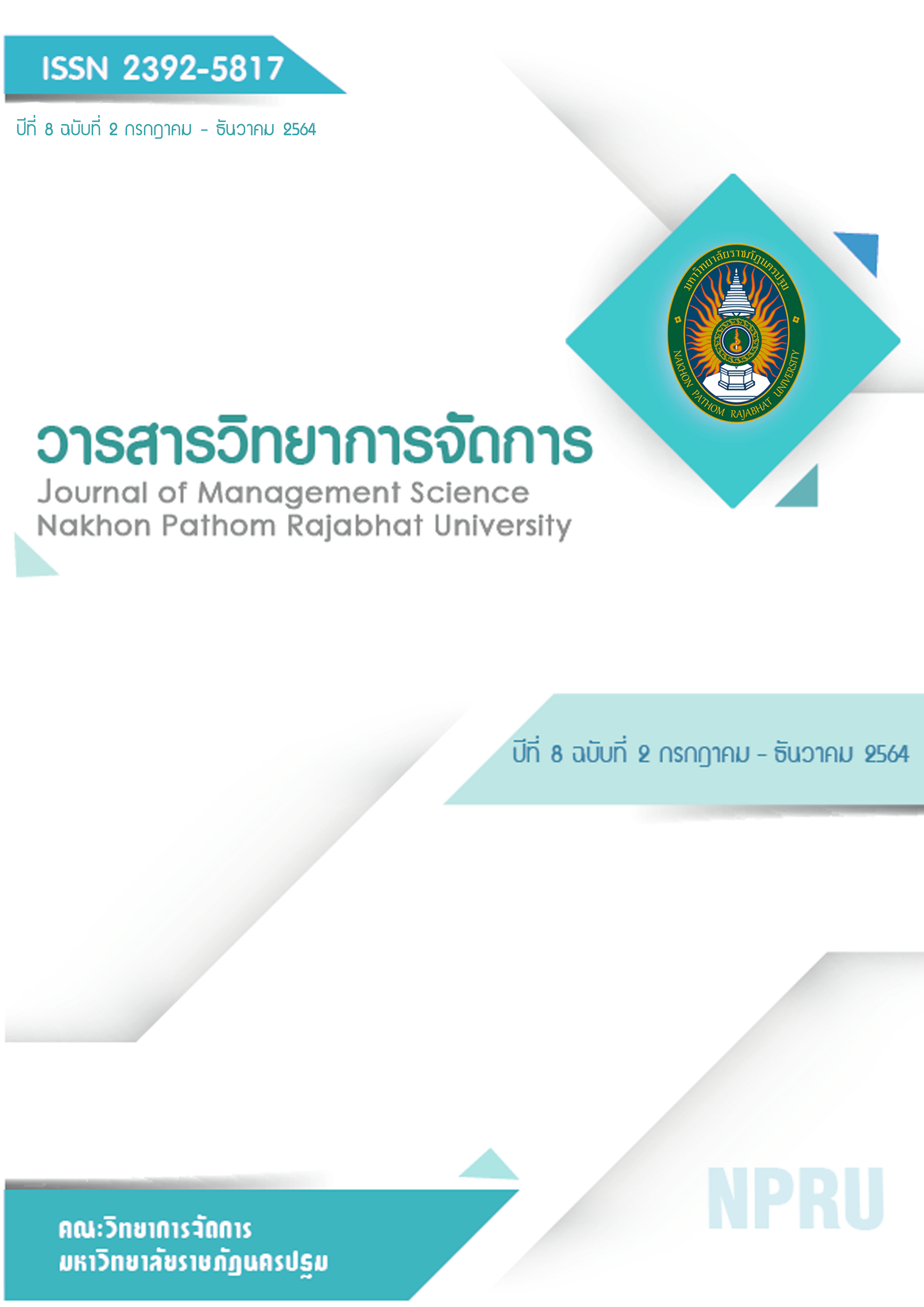Community Innovation Linking Community Economy to Sustainability
Main Article Content
Abstract
The purposes of this academic article are to study and review the basic information about the concepts, theories, researches of innovation linking to the community economy and to discuss the phenomena from the results of research related in the following issues; the meaning of innovation and community innovation, the components of community innovation, the community economic linking and the community sustainability. In this article, the definition of community innovation is creating creative differences to solve problems in the community, furthering knowledge or folk wisdom, including strengthening the community in the fields of economy, society, environment, education and balanced maintenance of local wisdom. There are 3 components of community innovation which are 1) innovations created to solve problems or promote a community 2) participation in community management by people in the community and 3) good relationships with internal and external networks. The linkage of the community economy involves the circular economy, the welfare and the strength of the community. In order to plan for the sustainability of communities in Thailand, it is necessary to consider the balance among economy, society, environment and education without neglecting the foundation culture of the community and preserving local wisdom and way of life. This finding support Stakeholders with community development for the guidelines for creating and develop community innovations to connect the community economy to sustainability.
Article history : Received 13 May 2020
Revised 5 June 2020
Accepted 8 June 2020
SIMILARITY INDEX = 0.90 %
Article Details

This work is licensed under a Creative Commons Attribution-NonCommercial-NoDerivatives 4.0 International License.
The views and opinions of the article appearing in this journal are those of the author. It is not considered a view and responsibility of the editorial staff.
References
จันทร์ศรี สิมสินธุ์ ภูษิต บุญทองเถิง และ ทัศนีย์ นาคุณทรง. (2559). นวัตกรรมชุมชนเพื่อการเรียนรู้ตลอดชีวิต. วารสารบริหารการศึกษา, 12 (1), 83-94.
จิตรลดา พันธุ์พณาสกุล และวรลักษณ์ ลลิตศศิวิมล. (2562). การสร้างความได้เปรียบทางการแข่งขันด้วยเทคโนโลยีสารสนเทศและนวัตกรรมของธุรกิจโรงแรมในประเทศไทย : การทบทวนวรรณกรรม.วารสารบริหารธุรกิจเทคโนโลยีมหานคร, 16(2), 19-39.
จุฑารัตน์ บันดาลสิน. (2557). การพัฒนาความคิดสร้างสรรค์สู่นวัตกรรมการบริการพยาบาล. วารสารพยาบาลทหารบก, 15(3), 9-17.
ญาณิศา เผื่อนเพาะ. (2562). การจัดการความเสี่ยงในธุรกิจขนาดกลางและขนาดย่อม. วารสารวิทยาการจัดการปริทัศน์, 21(1), 191 - 200.
ดนชนก เบื่อน้อย. (2559). นวัตกรรมกับความคิดสร้างสรรค์.วารสารวิชาการการตลาดและการจัดการมหาวิทยาลัยเทคโนโลยีราชมงคลธัญบุรี, 3(1), 1-12.
นพพร จันทรนาชู, พรรณ์ธิดา เหล่าพวงศักดิ์ และยุวรี ผลพันธิน. (2561). รูปแบบการประยุกต์ใช้ปรัชญาของเศรษฐกิจพอเพียงและความเชื่อมโยงกับเศรษฐกิจชุมชนที่มีผลต่อความสำเร็จในการบริหารจัดการสถาบันการเงินชุมชน. Veridian E-Journal, Silpakorn University, 11(2), 3217-3232.
บรรเลง อินทร์จันทร์. (2559). นวัตกรรมสังคมอันเนื่องมาจากพระราชด้าริในเขตพื้นที่ลุ่มน้ำปากพนังจังหวัดนครศรีธรรมราช. วารสารวิจัยมหาวิทยาลัยเวสเทิร์น มนุษยศาสตร์และสังคมศาสตร์, 2(2), 48-56.
ยุทธชัย ฮารีบิน สมนึก เอื้อจิระพงษ์พันธ์ และสุนันทา เสียงไทย .(2559). ความสามารถด้านเครือข่ายและความสามารถเชิงนวัตกรรมของวิสาหกิจขนาดกลางและขนาดย่อม. วารสารนักบริหาร Executive Journal, 36(2), 79-88.
รังสิยา นารินทร์ และเรณู มีปาน (2558). นวัตกรรมการจัดการดูแลสุขภาพของชุมชน: ‘อาสาปันสุข’. วารสารพยาบาลสาร, 42(4), 1-11.
สมนึก เอื้อจิระพงษ์พันธ์, พักตร์ผจง วัฒนสินธุ์, อัจฉรา จันทร์ฉาย และประกอบ คุปรัตน์ (2553). นวัตกรรม: ความหมาย ประเภท และความสำคัญ ต่อการเป็นผู้ประกอบการ. วารสารบริหารธุรกิจ คณะพาณิชยศาสตร์และการบัญชี มหาวิทยาลัยธรรมศาสตร์, 33(128), 49- 65.
สมบัติ นามบุรี. (2562). นวัตกรรมและการบริหารจัดการ. วารสารวิจัยวิชาการ, 2(2), 121-134.
สำนักงานคณะกรรมการพัฒนาการเศรษฐกิจและสังคมแห่งชาติ. (2017). ความเป็นมาของวาระการพัฒนาที่ยั่งยืน Sustainable Development Goals: SDGs). [ออนไลน์]. สืบค้นเมื่อ 27 เมษายน 2563, จาก http://sdgs.nesdb.go.th/about.
สำนักงานนวัตกรรมแห่งชาติ. (2549). ประวัติสำนักงานนวัตกรรมแห่งชาติ (องค์การมหาชน). [ออนไลน์]. สืบค้นเมื่อ 20 เมษายน 2563, จาก https://www.mhesi.go.th/main/th/org/1511-nia.html.
สำนักงานนวัตกรรมแห่งชาติ. (2562). ประเทศไทยอยู่จุดไหนในอันดับนวัตกรรมโลก (GLOBAL INNOVATION INDEX: GII 2019). [ออนไลน์]. สืบค้นเมื่อ 27 เมษายน 2563, จาก https://www.nia.or.th/GII2019.
สำนักวิชาการ สำนักงานเลขาธิการกรรมการสภาผู้แทนราษฎร.(2558). การมีส่วนร่วมของประชาชนกับการปกครองท้องถิ่น. เอกสารวิชาการอิเล็กทรอนิกส์ สำนักวิชาการ สำนักงานเลขาธิการกรรมการสภาผู้แทนราษฎร. 1-11.
เสาวลักษณ์ โกศลกิตติอัมพร และสัญญา เคณาภูมิ. (2559). หลักการเบื้องต้นเกี่ยวกับองค์การและการจัดการ. วารสารวิชาการ แพรวากาฬสินธุ์ มหาวิทยาลัยกาฬสินธุ์, 3(1), 170-193.
อรุณี ไพศาลพาณิชย์กุล. (2560). องค์การนวัตกรรม: มโนทัศน์ และตัวแบบเชิงทฤษฎี. วารสารพัฒนบริหารศาสตร์. 57(3), 158-187.
อุ่นเรือน เล็กน้อย. (2556). บทบรรณาธิการ. วารสารวิจัยสังคม Journal of Social Research, 36(1), i-v.
อุทัย ปริญญาสุทธินันท์. (2561). การพัฒนาองค์การ: ประเด็นทบทวนสู่การประยุกต์ใช้เพื่อการจัดการชุมชน. วารสารมหาวิทยาลัยศิลปากร. 38(6), 24-48.
Cleopatra, V., and Black, L. (2019). Creating and managing participative brand communities: The roles members perform. Journal of Business Research: 1-13.
Curie, P., and Tantiyaswasdikul, K., and Evans, S., and Lertwattanaruk, P., (2019). Innovation catalysts for industrial waste challenges: Sri Lankan and Thai cases. Procedia Manufacturing. 33: 570-577.
Jingcheng, F., and Wu, J., and Liu, C., and Xu, J. (2016). Leaders in communities of real-world networks. Physical A: Statistical Mechanics and its Applications. 444: 428-441.
Kendra, J. M., and Wachtendorf, T. (2007) Community Innovation and Disasters. In: Handbook of Disaster Research. Handbooks of Sociology and Social Research. New York : Springer,
Omer, M.A., and Noguchi, T. (2020). A conceptual framework for understanding the contribution of building materials in the achievement of Sustainable Development Goals (SDGs). Sustainable Cities and Society. 52: 1-14.
Prummer, A., and Siedlarek, J. P. (2017). Community leaders and the preservation of cultural traits. Journal of Economic Theory. 168: 143-176.
Robbins, S. P., and Coulter, M. (2002). Management. (7th ed). Englewood Cliffs, NJ : Prentice-Hall
Sherry, J. (2019). The impact of community sustainability: A life cycle assessment of three ecovillages. Journal of Cleaner Production. 237: 1-13
Suebvises, P. (2018). "Social capital, citizen participation in public administration, and public sector performance in Thailand. World Development, 109: 236-248.


